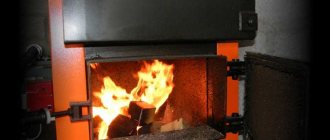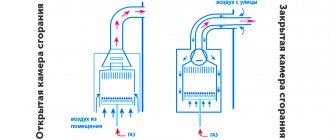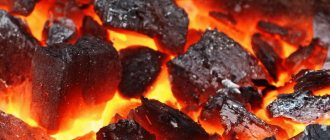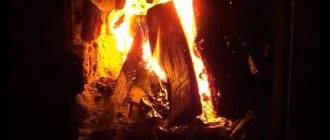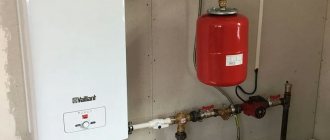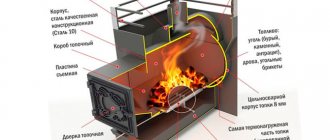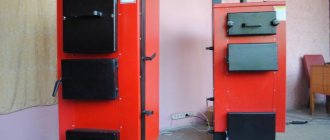31.10.2018
Nowadays, fuel for heating a home is not only conventional gas or electricity. Today there are a large variety of alternative solutions on the market, allowing you to choose the most suitable option for yourself, both in terms of energy supply and finance.
Next, we will look at why alternative fuels are so attractive, what they come in, and what we should ultimately choose.
Heating costs with a heat pump with a two-tariff meter.
When metered with a two-tariff meter, the price of 1 kilowatt of electricity from 7-00 to 23-00 is 2 rubles. 72 kopecks, and from 23-00 to 7-00 - 92 kopecks. With a heat pump COP of 3, these figures will be 91 kopecks, respectively. and 30.6 kopecks. Thus, the cost of heating our house will be:
150*5*(13*0.91+11*0.306) = 12756 rubles. In reality, taking into account the fact that heat loss at home increases at night, this figure will be slightly lower.
With COP = 5, we obtain the following arithmetic: The cost of heat at the daytime tariff is 0.544 kopecks, at night - 18.4 kopecks. In total, heating costs during the heating season will be:
150*5(16*0.544+8*0.184) = 7632 rubles.
Saving on finances
Let's remember right away: by saving money, you will never get the most economical and profitable heating for a private home. This is the main mistake of all developers. You invest money in building a big house, in decorating the outside and inside, but most often you forget about such fundamental things as heating.
Heating costs money, but you can still save money wisely. You can install the good old and proven gravity radiator heating system. It will be affordable and you will provide your home with warmth during the cold season. But this will not be the most economical heating system.
About choosing a heat source
It’s good if you are lucky and there is gas on the site. And if it is not there, then what to do? You can use liquefied propane gas, bury the gas tank, not forgetting to periodically service it and fill it on time.
You can use an electric boiler, if, of course, there is enough electricity power limit, you can use a solid fuel, wood, or pallet boiler, or you can use a boiler with a diesel burner or, which is now gaining popularity, a heat pump. The main thing is to know the costs of heating your home.
You can estimate how much the equipment and its installation cost quite accurately by calling specialized offices, but not everyone will ask how much they will then pay monthly for energy consumption. Even if he thinks about it, he is unlikely to find the answers.
So now we’ll figure out how much it costs to heat a house, or more precisely, how much does 1 kW of heat cost, depending on the choice of energy source?
CALCULATION OF THE COST OF GAS COSTS
To calculate gas consumption for heating, you must use the following formula:
V = Q / (n/100 x q)
- Q is the heat load for heating (kW/h), for example, let’s take 24 kW/h.
- q is the calorific value of the gas (kW/m³), which depends on the brand of gas supplied. To find out exactly what brand of gas is used in your home or area, we recommend contacting your gas supply company directly.
- n – coefficient of performance (efficiency) of a gas boiler, expressed as a percentage. It is indicated in the boiler passport.
For example, let’s choose a boiler - Lemax Premium 35 V. This boiler was chosen due to its technical power indicators, its value is very close to the thermal load value for a house with 300 m3, namely 24 kW/h. It is also worth noting the high efficiency rate of 90%. To ensure that the boiler power is enough to heat the house even in the most severe frosts, it is recommended to use a reserve of 30%. For the purpose of calculation, we take G20 gas with low calorific value, namely Hi = 9.5 kWh/m.
Now we substitute all the values into the formula and calculate:
V = 24 / (90.0 / 100 × 9.5) = 2.5 m³/h.
Thus, to heat 300 m3 per day you will need 60 m3 of gas. And for the heating season, it turns out to be 183 days (from October 15 to April 15), taking into account temperature fluctuations, you will need:
(60 m3 (daily gas consumption) x 183 days (heating season)) / 2 (taking into account temperature fluctuations) = 5490 m3
Solid fuels
Solid fuel used to be very popular. This is due to several reasons - the availability of most types of this energy carrier, low cost, poor level of gasification in populated areas, and the lack of free electrical power for electric heating complexes.
At the present stage, solid fuel is used less frequently. This is caused by a general rise in energy prices. Firewood of medium humidity costs 2–3 times more than gas, pellets – 3 times, black coal – more than 4 times. In addition, the construction of gas distribution systems is actively underway.
There are several main types of solid fuel:
- Firewood of various wood species with varying degrees of humidity;
- Coal of different types - black (long-flame, anthracite, etc.), brown;
- Pellets are granulated wood waste.
Boilers, stoves and fireplaces are used to operate on solid fuels. Most modifications of these devices require manual maintenance and operate in peak thermal mode. To equalize the thermal regime and increase the efficiency of heat use in water heating systems based on solid fuel units, it is recommended to use a heat accumulator.
A separate group among solid fuel boilers are long-burning boilers and pellet heat generators. They implement in their work the principle of high-quality combustion of all fuel components, primarily pyrolysis gas.
Pellets - granulated wood waste
Long-burning devices require fuel loading at a lower frequency; pellet boilers are equipped with automation and have a relatively independent operating mode. You can read about the design and operating algorithm of pellet boilers in a special publication.
The advantages of solid fuels are:
- No permit is required for installation of equipment;
- Low installation costs;
- Long service life;
- Availability of many types of fuel in most regions of the country;
- Possibility of organizing energy-independent heating.
Solid fuel thermal equipment also has disadvantages:
- Manual operation;
- Waste generation;
- Investments in the construction of a chimney;
- Low efficiency;
- Spasmodic thermal regime;
- Construction of a warehouse and creation of a fuel reserve;
- Large overall dimensions of brick stoves;
- The need for constant human presence and periodic cleaning of equipment.
A mandatory attribute when using solid fuel is a warehouse
Solid fuel boiler equipment is most often used in regions with close proximity to forests, coal mines, and large wood processing plants. It is also very popular in places of non-permanent residence - dachas, country houses.
Wood stove heating
If the house is built far from gas mains or you don’t want to pay for expensive coolant, you can install a wood heating system. This option is ideal from an environmental point of view and does not harm the health of residents. How does a wood heating stove work?
The operating principle of this design is simple and clear. You buy a stove, put wood in it, and light it. The wood burns and heats the stove equipment. The stove gives off heat and the air in the room warms up.
Despite the seemingly primitive design, this heating option has a number of advantages:
- the oven heats up quickly;
- there is no need to buy and install pipes, radiators, pumps;
- the design is reliable, designed for long-term use, and is difficult to damage;
- Firewood can be purchased inexpensively.
Modern heating stoves bear little resemblance to the well-known potbelly stoves. The design of the furnace is designed so that the installation gives off a lot of heat and can operate for a long time on one load.
The structure of a boiler for wood.
A boiler can be integrated into a wood heating system. When choosing a boiler, it is better to choose a pyrolysis type design. Heat will be generated as a result of combustion of pyrolysis gases. This type of boiler equipment can function without electricity.
Now about the disadvantages of this type of heating of buildings:
the furnace installation is quite large, you will have to think about where to install it; the equipment weighs a lot, so you won’t be able to install the stove yourself; near the house you will have to provide a covered room for firewood; it is important that the supply of wood is sufficient for the heating period; combustion products if the stove device is used incorrectly can be hazardous to health; when heating with wood, you will have to provide a chimney; the stove will heat the room unevenly.
Main fuels
Today, there are four types of fuel that have already been tested over the years, have been used for a long time and have proven themselves in one way or another.
- The first is natural gas. We have a lot of natural gas in our country. Therefore, it is quite cheap. If you don't consider the various nuances. But we'll talk about this a little later.
- The second method is liquefied gas. Or it is also called SPBT (technical propane-butane mixture). This gas is very often seen at gas stations. Cars are fueled with it. This gas can also be used for heating country houses and any premises.
- The third type of fuel is diesel fuel or diesel fuel.
- The fourth is electricity.
So, let's look at each of these types separately. What are the pros and cons, and its cost. Cost of investment and cost of operation per day, per month and per year.
Briquettes
For those who are not in the know, briquettes (aka Euro firewood) are bricks that are made from waste from the wood processing industry by pressing. There are a lot of myths and false opinions floating around this fuel. You can even find information that 1 ton of briquettes can replace an entire KAMAZ truck of ordinary firewood. However, such data is nothing more than advertising, which can only be verified in practice.
This doesn't mean that braces are bad fuel. Not at all. Firstly, due to its high density, Euro firewood is compact, which means it is easier to store than ordinary logs. Secondly, the so-called calorie content of braces is higher than that of the most energy-intensive wood (oak, apple tree). This means that you will have to throw them into the firebox less often. Thirdly, European firewood is dry by default, which makes it easier to use and also makes cleaning of chimney systems less frequent.
Unfortunately, today the price tag for pressed briquettes is still at an unreasonably high level. Yes, they are comfortable. Yes, compact. Yes, they burn for a long time. But do you want to pay extra money for this, which is not converted into heat, this is a big question.
The following conclusion can be drawn regarding briquettes. There is no economic benefit in terms of obtaining 1 kWh of heat for a specific amount of money when using European firewood. They are preferred only by those users who need solid fuel heating and are reluctant to bother with firewood. As practice shows, this type of fuel does not stay on the farm for long, since sooner or later the user returns to the good old ordinary firewood.
How much does it cost to heat a house: prices for different areas
| Economy | Standard | Premium | |
| Wall material | Backing brick 250 + Facing brick 120 | Backing brick 250 + Facing brick 120 | Backing brick 250 + Facing brick 120 |
| Design thermal power | 10.5 kW | 10.5 kW | 10.5 kW |
| S heated floor | NOT PROVIDED | NOT PROVIDED | NOT PROVIDED |
| Radiators | Steel panel (Türkiye) | Steel panel (Austria) | Steel panel (Austria) |
| Pipeline, material | Polypropylene | Metal-plastic (KAN-therm, Poland) | Cross-linked polyethylene (TESE, Germany) |
| Pipeline, diagram | Two-pipe | Two-pipe | Collector |
| Boiler | Double-circuit non-condensing wall-mounted boiler, 24 kW (Fondital, Italy) | Double-circuit non-condensing wall-mounted boiler, 24 kW (Fondital, Italy) | Single-circuit non-condensing wall-mounted boiler, 24 kW (Fondital, Italy) |
| Boiler room equipment | A set of the minimum required set of materials | A set of the minimum required set of materials | A set of the minimum required set of materials |
| Automation | NOT PROVIDED | NOT PROVIDED | Thermostatic valves with thermal head on radiators + room regulator |
| Equipment for hot water supply | By means of a double-circuit boiler | By means of a double-circuit boiler | Indirect heating boiler with a volume of 150 liters (Huch EnTEC, Germany) |
| Cost, m2 | RUB 1,360/m2 | RUB 1,889/m2 | RUB 3,011/m2 |
Advantages of combined boilers, principles of operation
To ensure autonomous heating, a boiler is used, the main requirement of which is uninterrupted and efficient operation. Price also plays an important role.
One of the types of heating units that meet the above requirements are combination boilers.
A combined heating boiler is a unit that burns several types of fuel to heat the coolant.
Classification of combination boilers
There are many different boiler designs that combine the ability to burn different types of fuel:
- By the amount of fuel burned: 2, 3 or 4 types.
- By type of fuel burned: gas and diesel fuel; solid fuel and liquid, solid fuel and electricity, etc.
- By design: the boiler has several fireboxes and burners.
Combined boilers for 2 types of fuel
Units using 2 types of fuel can operate according to different schemes:
- A gas boiler may have a design that allows you to replace the gas burner with an oil burner.
- There are burners that can operate on both liquid and gaseous fuels.
- Many solid fuel boilers are equipped with an electric heater as backup heating of the coolant.
Combination boilers for 3 types of fuel
Units using 3 types of fuel can be of different modifications:
- Most often these are boilers that have a furnace for burning solid fuel, but with the ability to install a suspended burner for gas and liquid fuel.
- There are models that are designed with 2 separate combustion chambers, providing the ability to burn different types of fuel.
Combination boilers for 4 types of fuel
The most versatile type of heating boiler is a unit that can heat the coolant from four different types of fuel. Its design includes a built-in electric heater and 2 separate combustion chambers:
One combustion chamber is designed to burn gas and liquid fuel.
The second firebox is used for burning solid fuels (coal, peat, firewood, sawdust, pellets and others).
Advantages of combined heating boilers:
- Independence from one type of fuel.
- Complete energy independence is possible.
- Possibility of automatic switching to a reserve type of fuel in case of failure of the main one.
Combination boilers have different levels of automation and keep up with gas and electric models.
Disadvantages of combined heating boilers:
- It is necessary to have a place to store all types of fuel.
- The installation of the unit must comply with the requirements for boilers of all types of fuel that are used.
- Reduced efficiency, especially when burning solid fuel.
The combi boiler must be equipped with all the necessary safety elements that are mandatory for each type of fuel. For example, to control gas leaks, you need to install gas analyzers, and to reduce the risk of electric shock, grounding, etc.
Boiler brands
The CTC 2200 Trio boiler (Sweden) is equipped with an electric heater and is capable of operating on solid, liquid and gaseous fuel. Thermal power generation:
- Electric heater: 3-15 kW.
- Solid fuel: 30 kW.
- Diesel fuel: 45 kW.
- Gas: 45 kW.
The unit is equipped with a water heater for the domestic hot water system and an automation system.
Average price: 580,000 rubles.
Jaspi Tupla S boilers (Finland) are similar in characteristics to the previous brand.
They are capable of running on all four types of fuel, but the maximum power is limited to 25 kW. The price is about 300,000 rubles.
A combi boiler can be a solution if there are difficulties in supplying the main fuel. This will ensure uninterrupted heating operation, which is especially important in winter.
No comments yet
otoplenie-pro.com
How to optimize heating costs?
You should know the following:
The greater the height of the room, the higher the heat loss. Plastic windows retain heat better than wooden ones. Corner apartments have more heat loss than apartments located in the middle of the house. Apartments on the top floor require more heat for heating. When installing radiators, you need to take into account that there should be 20% more batteries than necessary according to calculations, so that they provide full heat transfer in the event of breakthroughs, extreme frosts or other emergency circumstances
Please note that in terms of heat transfer, the following indicators are used in the standard calculation: cast iron radiators have 145 W, bimetallic – 185 W, aluminum – 190 W. In addition, in order to optimize heating costs, you need to properly seal the room, install double-glazed windows, eliminate all kinds of cracks and cracks, insulate the walls
The amount of heat loss is also influenced by different climatic conditions of the region
In addition, in order to optimize heating costs, you need to properly seal the room, install double-glazed windows, eliminate all kinds of cracks and cracks, and insulate the walls. The amount of heat loss is also influenced by different climatic conditions of the region.
The good thing about the heating cost calculator is that you don’t have to spend a long time calculating the cost of heating your home using complex and obscure formulas. You just need to measure correctly and indicate the requested data in the online program to get the most accurate result for your home.
Having made preliminary calculations and compared their results, the editors of santehnikportal.ru came to the conclusion that the most economical type of fuel is natural gas, and the most expensive fuel is electricity.
Use our online heating calculator and don’t be afraid of any frost!
- https://dekormyhome.ru/remont-i-oformlenie/kak-rasschitat-rashod-na-otoplenie.html
- https://diy.obi.ru/articles/schitaem-rashodi-na-otoplenie-v-zagorodnom-dome-511/
- https://domsdelat.ru/elektroprovodka/rashod-elektroenergii-na-otoplenie-doma-100m2.html
- https://eurosantehnik.ru/rasxody-na-otoplenie-doma.html
- https://santehnikportal.ru/calc/rashody-na-otoplenie.html
Features of a liquid coolant system
Heating systems with coolant in the form of liquid are perhaps the most popular in our country. This is understandable, because they are familiar and quite effective. The basis of such a system is a closed-type heating circuit with a heating device, inside of which there is a heat exchanger. Liquid passes through it and heats up to the desired temperature.
Next, the coolant goes through the pipes to the heated rooms. Here it enters the radiators, where it gradually cools, giving off heat to the surrounding air. The cooled liquid moves towards the heating device, enters the heat exchanger and the cycle repeats.
Such a system is also called water heating, but this is not entirely correct, since various compounds can be used as a coolant - for example, antifreeze.
A liquid coolant system necessarily includes a pipeline through which water or antifreeze circulates, and heating devices installed in the premises
The undoubted advantage of such a system can be considered its variability. There are many different wiring schemes to ensure the most efficient heat supply for specific conditions.
There are water heating with forced and gravitational circulation. In the first case, a pump is used to supply the coolant, which makes it possible to implement circuits of varying complexity and length. The second option has many limitations, but is completely energy independent.
Heating systems with liquid coolant can be implemented in many options. This is, for example, what a two-pipe wiring diagram looks like: the coolant enters through one pipe, and out through the other
The system can be configured with one- or two-pipe wiring. The first is extremely simple and economical, but not effective enough for a large house. The second is more complex, but allows high-quality heating of buildings of any size. Depending on the type of system chosen, the set of equipment necessary for its installation also differs.
An integral element of any of them is the boiler, the type of which largely determines the operational characteristics of the system. Let's look at the most popular devices.
Option #1 - using gas equipment
A gas boiler is considered the most economical of all analogues. It works extremely simply. The gas enters the combustion chamber, where it burns, releasing heat, which is transferred to the coolant liquid through a heat exchanger.
The equipment is diverse and, accordingly, has different properties. Turbocharged equipment is considered the safest and most efficient.
It does not require the installation of a traditional chimney, does not take air from the room and has the highest efficiency.
Floor-standing varieties of gas boilers include models with maximum power. They are capable of heating 2-3-story cottages of any size
Devices with an open chamber are characterized by low efficiency and require high-quality ventilation and a traditional smoke exhaust system. At the same time, they are completely energy independent, and their cost is minimal. But it is important to install and connect the equipment correctly.
The advantages of heating with a gas boiler include the following features:
- Low fuel cost, it increases very slowly.
- High equipment efficiency.
- Possibility of full automation of the heating system.
- Cleanliness in the premises, since fuel combustion does not produce large amounts of ash and soot.
- Wide range of gas equipment.
Among the disadvantages, it is worth noting the potential danger of using gas. Great care is required when working with it. All maintenance and installation work may only be carried out by certified specialists.
In addition, special permission will be required to connect gas equipment. The cost of devices and their installation is quite high; the possibility of connecting to a gas main does not exist everywhere.
Option #2 - use of a solid fuel boiler
These are heating devices familiar to many. Their operation requires solid fuel: calibrated coal, firewood, peat, pellets, etc. The operating principle is similar to gas ones, they differ in the type of burner.
Modern modifications of long-burning are characterized by the fact that one load of fuel is enough to maintain the flame for half a day or more. The simplest models are non-volatile, require constant human control and have low efficiency.
Solid fuel boilers are not always easy to use. The simplest models require constant fuel loading, frequent cleaning and maintenance
Improved devices can be equipped with automated control and automatic fuel supply. True, the latter applies to pellet equipment. Such devices, when connected correctly, are quite effective and reliable.
The advantages of solid fuel equipment are:
- Simplicity and reliability of the design, which significantly extends its service life.
- The budget cost of the equipment and the possibility of carrying out its installation and subsequent maintenance yourself.
- There is no need to obtain special documentation for the installation of such a boiler.
- A wide selection of devices with different functionality and power.
The equipment also has significant disadvantages. First of all, this is the need to create a fuel reserve, which must be stored in proper conditions. Solid fuel boilers, especially their simplest modifications, are not very easy to use. There is a large amount of soot and soot, so very frequent cleaning of the device is required. In addition, you will also have to load fuel quite often.
Option #3 - using an electric boiler
You can also heat the coolant in the system using electric boilers. It is generally accepted that this is a very uneconomical method. However, this is not quite true. You need to understand that several types of electrical equipment with different characteristics are produced.
Heating element and electrode models
Heating element models are the simplest and most ineffective. They heat the coolant using tubular electric heaters lowered into it. The devices consume a large amount of electricity with a relatively low efficiency. At the same time, the heating elements in the liquid fail quite quickly.
Electrode boilers are more economical and reliable. In them, the coolant moves inside the boiler, where two electrodes are installed. When an electric current is applied, the liquid heats up very quickly.
Electrode boilers are compact and efficient. Thanks to their design, they are very durable and can last for decades.
Induction boiler type
The most efficient and economical type of electrical equipment is induction boilers. Thanks to the presence of two circuits, magnetic and thermal, they manage to heat the coolant liquid as quickly as possible.
The advantages of all types of heating devices include:
- Quick heating of the coolant and, accordingly, the room.
- Compact equipment.
- Simple installation, which is carried out without first obtaining permission.
- No chimney installation is required.
- Comfortable operation, possibility of equipping with automatic control.
- Complete safety and environmental friendliness.
Among the disadvantages, the rather high cost of operation is usually noted, which is a consequence of the high price of energy.
True, depending on the type of boiler and the presence or absence of automated system control, heating costs can vary significantly. Induction boilers, fully equipped with automation, are quite economical and pay for themselves quite quickly.
Combined heating boilers
On sale you can find combination heating boilers that can operate with several types of fuel. These are more expensive devices, the main advantage of which is the ability to provide the house with heat in conditions of interruptions in the supply of the main type of fuel.
A combined or multi-fuel boiler is a universal heating device, indispensable for areas where there are interruptions in the supply of different types of fuel
The common advantages of all heating systems with liquid coolant are low cost and availability, fairly high efficiency and many design options.
The disadvantages include not the most comfortable temperature distribution in the rooms. Warm air is at the top and cooler air is at the bottom.
In addition, water systems fail if the temperature in the building drops below freezing. Systems with antifreeze and saline solutions do not have this drawback. However, antifreezes are expensive and toxic, and salt solutions provoke rapid corrosion of the system.
Choosing fuel for heating - which is cheaper?
How to decide on the type of fuel for a heating boiler? Let's just do the math.
Numerous advertising statements from sellers of heating equipment and multi-page disputes on the Internet about the unprecedented efficiency of using certain heating boilers using one type of fuel or another have led to the desire to pick up a pencil, open reference books, call fuel sellers and, finally, finally figure it out — how much does heating cost using different types of fuel?
The calculations were based on the calorific value - the specific heat of combustion of a kilogram of fuel. The calorific value of kilograms was converted into convenient, generally accepted trade units for different types of fuel, liters, cubic meters and the same kilograms.
The price per kilowatt of heat that can be released when burning a specific type of fuel turned out to speak for itself. But heating boilers using different types of fuel also have different efficiencies.
Solid fuel boilers have the lowest efficiency, gas boilers have the highest efficiency, and diesel fuel boilers are close to gas boilers. Therefore, the average parameters of different types of heating boilers were taken and the price per kilowatt of heat received was calculated, taking into account the efficiency. I suggest you look at the table in which the calculation results were summarized. They turned out to be quite expected for me, but obviously contradicting popular stereotypes and statements of cunning marketers:
| Type of fuel | Price in rubles | Calorific value | Price per kilowatt of heat | Boiler efficiency for a given fuel | Price kW of heat taking into account efficiency |
| Dry firewood, kg | 5 rub. | 3.6 kW per kilogram | RUB 1.39 | 70% | 1 ruble 98 kopecks |
| Quality coal, kg | 3 rub. | 7.5 kW per kilogram | 0.4 rub. | 70% | 57 kopecks |
| Natural gas, m3 | 4.2 rub. | 9.7 kW per cubic meter | 0.43 rub. | 92% | 47 kopecks |
| Liquefied gas, liter | 18 rub. | 6.4 kW per liter | 2.8 rub. | 92% | 3 rubles |
| Diesel fuel, liter | 27 rub. | 10.3 kW per liter | 2.6 rub. | 88% | 2 rubles 95 kopecks |
| Electricity, kW | 2.18 rub. | 1 kW | 2.18 rub. | 99% | 2 rubles 20 kopecks |
| Pellets, kg | 6.5 rub. | 5 kW per kilogram | 1.3 rub. | 70% | 1 ruble 86 kopecks |
So, our hit parade of cost per kilowatt:
The most expensive type of fuel turned out to be liquefied gas - 3 rubles per kilowatt.
Second place, with a very small gap from the leader, is taken by diesel fuel - 2.95 rubles per kilowatt.
Electricity closes the top three at 2.2 rubles.
Dry birch firewood comes in fourth place - 1.98 rubles.
Wood pellets (pellets) breathe in the back of firewood - 1.86 rubles.
High-quality graded coal unexpectedly surpasses natural gas in cost with a price of 57 kopecks.
And closing the list, occupying an honorable place as the leader in savings, is our asset - natural gas, with a price of 47 kopecks! Ta-daa!
Now that the cost of heating energy is known, let’s supplement it with the estimated cost of boiler equipment and, as an example, take the most popular power of 24 kilowatts:
For liquefied gas, boiler and gas tank: 350-550 thousand rubles.
For diesel fuel, boiler and fuel tank: 90-150 thousand rubles.
Electric boiler: 20-35 thousand rubles.
Solid fuel boiler: 30-50 thousand rubles.
Pellet boiler: 200 thousand rubles.
Natural gas boiler: 25-60 thousand rubles.
Conclusions:
Installing a boiler for liquefied gas with a gas holder is an absolutely meaningless economically, obviously unprofitable idea, in fact, a marketing deception of the consumer.
In addition to the cost and payback period of several centuries, colossal excavation work is also required, compliance with requirements at the installation site, removal of several Kamaz trucks of soil, delivery of several Kamaz trucks of sand for backfilling, ensuring normal evaporation of liquefied gas in winter at temperatures below -20, periodic pumping of gas condensate from the gas tank and so on, and so on...
If there is no natural gas, and you don’t want to bother with solid fuel, then it would be quite appropriate to install a diesel boiler, or an electric one, if the allocated power allows.
And it would definitely be appropriate to install an electric boiler in a small house with good thermal insulation.
You may also be interested in:
Wall-mounted gas combi boilers
Examples of installation of heating systems
Comparative analysis based on other criteria
In addition to the purely economic calculation of the cost of heating, there are other factors that influence the choice of energy source. For example, it is difficult for an elderly pensioner to chop and carry firewood to the boiler room. Some people don’t like the smell of diesel fuel or the dirt from coal, while others don’t have the opportunity to store a supply of pellets or briquettes. That is, choosing fuel for heating only from the point of view of economy is wrong. Additional criteria need to be taken into account:
- comfort during use;
- possibility of storage;
- frequency and cost of service.
Nuances of operation
It is most convenient to use electricity for heating, although it is difficult to classify it as an economical energy source. The electric boiler does not require supervision, the system is fully automated. The unit is easy to control remotely, and the boiler room is quiet, clean and free of unpleasant odors. An important point: the electrical heating installation does not require a chimney, which greatly simplifies and reduces the cost of installation.
In addition to the high price, electric heating has another disadvantage. Not every private home has sufficient electrical power or a limit has been set that does not allow the use of energy for heating. And connecting units with a power of over 6 kW requires a 3-phase input with a voltage of 380 V.
It is almost as comfortable to operate boilers that burn natural and liquefied gas. But they require a chimney and good ventilation of the furnace room. Burning diesel and used oil is no longer so comfortable, since an odor inevitably appears and periodic replenishment of the fuel container is required. In this respect, a diesel heat generator is similar to a pellet heat generator, but the latter benefits from the absence of odors and dirt.
The champion in inconvenience is the wood and coal boiler, which requires constant attention and physical exercise. With the most economical method of heating with wood, the smell of combustion and dust mixed with dirt in the boiler room cannot be avoided (especially for coal). An exception is an automatic coal boiler, which operates on the principle of a pellet boiler, but it also requires periodic replenishment of the bunker.
Automatic boilers: pellet (right) and coal (left)
About fuel storage
The nuances of warehousing and storage are easier to identify in the list:
- The electric and gas heating system of a private house operates from external sources; no storage is needed.
- For reliable operation of any solid fuel boilers, you need a supply of fuel; accordingly, it is necessary to organize its storage. You will have to make a firewood shed under a canopy or a warehouse in a barn.
- The supply of diesel fuel and waste also needs to be stored somewhere and, preferably, outside the residential building. It is necessary to purchase and install a container of sufficient volume.
- The most difficult thing is to organize storage with autonomous heating using liquefied gas as an alternative to natural gas. The cost of an underground gas tank and its installation will quickly make you forget about economical heating of your home.
Not everyone can afford to install a gas tank, and constantly carrying cylinders to refuel is hard work.
There is another, cheaper way to store liquefied gas - in cylinders. But “thanks to” frequent replacement and refilling of cylinders, comfort when operating a propane boiler is equal to exercises with firewood when loading a solid fuel heat generator.
Equipment service
Electric heating systems require virtually no maintenance (check and clean once every 2 years). If it were not for the draconian daily tariff, then with the help of electricity it would be possible to organize a “economical smart home” system. Gas boilers will have to be serviced more often; they require annual preventive cleaning of the heat exchanger and chimney. But here you can save money if you clean the unit yourself, as described in this article.
Due to the low quality of diesel fuel, diesel heat generators will need to be cleaned as they become dirty, which can happen several times a season. The same applies to waste oil boilers, and the cleaning process is very dirty. Faced with problems like this in the middle of winter, you'll think twice about whether you need energy-efficient heating while working.
It is advisable to clean the smoke pipes with the firebox of a boiler using wood and pellets once a week, and the ash pan - daily
When working with wet wood from the combustion chamber, it is important to remove soot and tar more often before they become completely stuck.
Main fuels
Today, there are four types of fuel that have already been tested over the years, have been used for a long time and have proven themselves in one way or another.
- The first is natural gas
. We have a lot of natural gas in our country. Therefore, it is quite cheap. If you don't consider the various nuances. But we'll talk about this a little later. - The second method is liquefied gas. Or it is also called SPBT (technical propane-butane mixture). This gas is very often seen at gas stations. Cars are fueled with it. This gas can also be used for heating country houses and any premises.
- The third type of fuel is diesel fuel or diesel fuel.
- The fourth is electricity.
So, let's look at each of these types separately. What are the pros and cons, and its cost. Cost of investment and cost of operation per day, per month and per year.
https://youtube.com/watch?v=oCRBHHlPllQ
Comparative characteristics of engines
Considering the features of engines, you can understand which fuel will be the best option for your equipment:
Diesel
Advantages of engines running on diesel fuel:
- Economy.
- Power.
- Durability.
Gasoline
Gasoline engines are popular due to:
- Low cost of maintenance.
- Frost resistance.
- Undemanding to fuel quality.
Gas
Gas is used as an alternative to gasoline. To switch to this fuel, you will need to convert your car. This fuel does not always provide the power you get from fuel-efficient diesel or gasoline. Among the advantages are low cost and moderate consumption.
Features of gas holder (liquefied) fuel
A gas holder (GasHolder) is a banal tank for storing gas (propane + butane). It is pumped there in liquefied form. Then gradually this “liquid” turns into a gaseous state, increasing the pressure in the container. And due to the high pressure, the gas is squeezed out of the tank into the pipes for supply to the house.
The use of propane and butane in gas holders is due to the presence of these gases in fairly large volumes and the simplicity of their liquefaction technology
In fact, butane and propane are by-products remaining after the separation of methane from “natural gas” raised from the depths. Their share in the mixture pumped out of the ground often reaches 30%.
Plus, they are formed during the processing of associated gas, which comes out of wells along with oil. They have to either be burned in flares at the field, or find ways to use them in the energy sector.
Gas tanks can be used to store various gases. But for autonomous gas supply to private homes, it is customary to use equipment designed for a propane-butane mixture. It is also called liquefied petroleum gas (LPG). Liquefying methane for injection into such household containers is too expensive and unprofitable.
A mixture of liquefied propane and butane (LPG) differs in:
- winter;
- summer
Butane is cheaper than propane. But it freezes faster at negative atmospheric temperatures, so it is added to the winter mixture in smaller proportions. In winter, LPG is more expensive not because of the desire of power engineers to earn more, but because of the technological need to increase the percentage of expensive propane in it.
However, it is not worth purchasing liquefied gas for future use in the summer. In winter, with severe frosts, the summer composition may “freeze”. It will not turn into ice, but it will change from a liquid to a gaseous state in smaller volumes.
The capacity of a gas tank is usually calculated so that there is enough hydrocarbon gas in it for six months of uninterrupted operation of all gas equipment installed in the cottage
Gas holders are vertical and horizontal, and are also divided into:
- underground;
- aboveground.
In Russian climatic conditions, it is recommended to install only the underground version. At low outside temperatures, liquefied propane-butane begins to evaporate less efficiently.
It is easier to dig a deep pit so that the bottom of the gas tank is below the freezing level of the soil in the area. It is more expensive to insulate and artificially maintain the temperature parameters required for evaporation in the container by installing special evaporators.
Some “experts” claim that vertical gas holders have lower thermal efficiency compared to their horizontal counterparts. The evaporation mirror inside them is much smaller. And indeed it is. The smaller the area of liquid on top means less of it evaporates.
However, in vertical LPG tanks the evaporation process occurs at a slightly higher rate, which fully compensates for the smaller size of the “mirror”. The end result is almost the same. It is not for nothing that in Scandinavia, where the climate is in many ways similar to Russia, they prefer to install gas tanks in a vertical design.
Heating a country house with liquefied gas
If there is no gas main nearby, you can heat the house with liquefied gas (a mixture of propane and butane). It's not much more expensive. Gas has no expiration date. The main problem is the supply and storage of fuel. Cylinders are used to heat small houses; for cottages with a significant living area (for example, for two-story houses made of foam blocks), an underground storage tank (gas holder) is installed. The heating system is connected to it.
Heating cylinders have a volume of 30-50 liters. The gas container is installed outside, in a special cabinet near the wall of the house. The pipe connecting the cylinder to the boiler should not have threaded connections or sharp corners.
Rules for using gas cylinders:
- It is prohibited to gasify basements and basements
- It is necessary to provide free access to the tank from all sides
- Do not expose the gas container to heat or direct sunlight.
- It is not allowed to operate tanks with damaged housings or corrosion.
- The distance from the cylinder to the boiler must be at least 1 m
For a continuous supply of fuel, it is best to install several cylinders. They are connected through a special ramp that has a flexible connection, a gas pressure measurement sensor and a safety valve. If the cylinder heats up, the valve releases excess gas, thereby reducing the pressure inside the cylinder.
Gas boilers operating on natural and liquefied gas have no fundamental differences. The only thing is that when connecting a cylinder, due to the high calorific value of liquefied gas, it is necessary to install a nozzle of a smaller diameter.
Any houses for permanent residence, whether made of foam blocks or frame houses. need a heating system. The comfort of living depends on how well the heating system and other utilities are implemented.
Even if you do not plan to build a house for permanent residence, but only for seasonal residence, you still need a toilet, for example, a peat one. And for this, in turn, a cesspool is needed. Read about the process of constructing a peat toilet for your dacha in this article. about the construction of a cesspool - here.
Finally. Installation of gas heating is best left to specialists. Unprofessional installation of equipment is fraught with more than just breakdowns. The health and lives of users are put at risk. A properly installed system is convenient, safe, and economical, because the homeowner can independently regulate the temperature of radiators and hot water.
Which gas boiler is better to install in the house? Their types and characteristics
A gas boiler is a device for producing thermal energy through the oxidation process of natural gas. Boilers are designed to maintain heat in residential premises and to heat water.
Principle of operation
The principle of operation of a gas boiler comes down to the fact that a torch is ignited by a piezoelectric element, which ignites the main burner, which, in turn, heats the heat exchanger through which water moves.
To protect the consumer from possible accidents (since natural gas is flammable, poisonous, and explosive), the boilers are equipped with an automatic system that, if the torch goes out, turns off it and the gas supply to the main burner.
Constant maintenance of the coolant temperature is ensured thanks to a control valve and a thermocouple that measures the temperature.
Classification
Gas boilers are divided into industrial-type devices and for domestic needs. Production-type products are used to produce both high-pressure and low-pressure steam.
Gas boilers for domestic use are designed for heating and hot water heating (DHW). They are divided into:
- single-circuit;
- double-circuit;
- flow-through.
Single-circuit devices are used for heating. Double-circuit - for heating and hot water supply. Flow-through products are designed for heating water used for domestic needs.
By type of installation, boilers are divided into:
- floor;
- wall-mounted
Based on the type of combustion chamber, they are divided into boilers with:
- open camera;
- closed camera.
In an open combustion chamber, the oxidation process occurs with natural air movement (natural draft). In a closed combustion chamber, draft is provided by a built-in fan in the boiler itself.
Comparison of different types of boilers
The advantages and disadvantages of various types of boilers (in relation to each other) can be noted as follows:
- floor-standing devices are more powerful than their wall-mounted counterparts, but the latter are more compact in size;
- single-circuit products do not perform the function of providing hot water; moreover, they require additional installation of a pump that will pump coolant through the heating system;
- the process of providing hot water with dual-circuit devices is accompanied by large costs of water and gas, since a considerable amount of time will pass until the liquid of the required temperature reaches the consumer;
- with an open combustion chamber, the product is most convenient for installation, and also does not require an additional fan connection;
- flowing gas devices are not used for space heating.
Comparative analysis based on other criteria
In addition to the questions: the cheaper it is to heat a house, fuel consumption and efficiency, various heat generation options can be compared according to other parameters:
- From an environmental point of view, it is better to use equipment that runs on electricity. Then there is a gas boiler and combined gas-electricity systems.
- Electric convectors and infrared emitters have advantages in terms of complexity and cost of maintenance. The most demanding in terms of this parameter will be solid fuel systems, which require daily cleaning and loading.
- In terms of installation complexity, hybrid systems rank first, for example, solar collectors - gas boiler. The easiest to install is electrical equipment, followed by solid fuel boilers. Gas devices are installed, tested, and serviced only by special organizations and require a large number of permits.
- According to safety criteria, any heating system can lead to unpleasant consequences if used incorrectly. Possible electric shocks, fires, and gas explosions.
Nuances of operation
Heating systems have their own operating characteristics depending on the quality of installation and type of equipment.
Systems of the same type work differently because:
- fuel of a different quality is used;
- coolant parameters differ;
- a local zone of low pressure has formed in the expansion tank;
- air is sucked into the circuit due to a leak;
- air diffusion occurs through the surface of pipes made of plastic;
- During the installation of the pipeline, plugs were allowed to form, for example, when soldering pipes.
About fuel storage
To prepare a supply of firewood for the entire season, you will need a room protected from moisture. Coal, briquettes and pellets also require special storage conditions.
To contain liquid fuels, you will need a plastic or metal container, which should not be in the basement.
Equipment service
Primary and additional heating in a cottage or private house require periodic inspection, repair and replacement of components. The following signs indicate the need for work:
- Coolant is leaking from radiators and pipes;
- seething or noise is heard in the system;
- uneven heating in different rooms and floors;
- The system functions worse than at startup.
Possible causes of problems:
- design errors;
- the tightness of the connections is broken;
- Radiators are installed incorrectly;
- air pockets interfere with coolant circulation;
- equipment was installed in bad faith;
- due to incorrect connections, the system was unbalanced;
- use of low-quality components.
Inappropriate options
There are several types of electrical equipment designed for space heating, but not recommended for use as the main heat source:
- Heat fans. These devices have the simplest design and are a large hair dryer consisting of a heated coil and a fan that drives a flow of air through it. Their use will definitely not be cheap - the air cools down extremely quickly, and it will not be possible to maintain a comfortable temperature for a long time. Do not forget also about the load on the electrical network and the dangers - too dry air is harmful to house plants and people.
- Oil radiators are probably the most common device used by residents of apartment buildings when the central heating power is not enough. Surprisingly, this is also the least efficient heating method. And even if you manage to heat the room to a comfortable temperature, it won’t be cheap at all.
Why is this equipment so widespread if it is ineffective? The fact is that all of these are auxiliary devices designed to help out in emergency situations or when the main heating does not cope with its tasks. For a garage, for example, constant heating is not always needed. During repair work, it can be heated using a heat gun (fan heater) powered by electricity or gas. But in a house where it is necessary to constantly maintain the temperature at a certain level, infrared panels are much more effective.
Advantages of electric heaters
If you decide to make autonomous heating at home, the most economical way is to use gas fuel. In second place after it is electric heating. Electric heaters have an advantage over stove or water heating for the reason that the installation and maintenance costs of the latter two systems make them uneconomical.
Electric heating of a cottage has the following advantages:
- Electric heaters are characterized by silent operation, do not require transportation and storage of fuel and do not emit harmful substances that pollute the atmosphere. Such devices can simply be connected to the electrical network. They do not need to be allocated a separate room with good ventilation and a chimney, as for a gas boiler, and they also do not need to be regularly cleaned of soot and ash, like solid fuel boilers. In addition, you will not need additional space for storing fuel.
- To install electric heating, you do not need to make significant financial investments at the initial stage, as when installing systems with a liquid coolant. Heaters can be purchased as funds become available and installed in the desired room.
- To make economical heating using electricity, you can use two-tariff meters or install solar panels on the roof of the house.
- You can connect electric heating devices yourself without turning to specialists for help.
What do the costs depend on?
What determines heating costs?
Using the techniques and formulas of precise technical calculations, which will take into account absolutely the entire range of possible heat losses in the building, which are possible through the walls of the pipeline, building structures, through window and door openings, the number and size of which is determined by the architectural design of the structure, etc.
These characteristics are individual, and trying to bring them to a common denominator is only wasting your energy and time.
However, experts believe that if you make a preliminary calculation, which will be based on a typical suburban building, and on its basis, with approximate, but very close to the real values of the figures, it will be much easier for the owners of suburban areas to decide on the choice of the most optimal and priority heating system system.
So, for example, you can take a country cottage as a standard, which has a standard indoor ceiling height of 2.2 meters.
The total area of the cottage will be 200 square meters.
It is also necessary to take into account that for central Russia, it is not typical to use large panoramic windows, glass walls and a light-conducting roof for attics or attic greenhouses in suburban construction.
The owner of the described cottage, which will be equipped with a heating network, expects the following monetary costs:
- Purchase and installation of a boiler, heating and metering devices, laying of various pipelines, installation and purchase of shut-off, regulating and locking devices;
- Monthly payment for maintenance of heating utility networks;
- Periodic purchase of fuel, which is necessary to fully heat the building;
- The cost of laying the pipeline will directly depend on the total length of the entire heating circuit, the price of maintenance will depend on the type of generator used that generates thermal energy and the complexity of the utilities used.
The main expensive element of the upcoming expenses and the main component of the entire heating system will be the fuel boiler, which, by processing a certain type of fuel, will produce the necessary thermal energy.
Pipes for heating system
The choice of material for pipes depends on the type of heating system and the financial capabilities of the developer. In case of force majeure, the possibility of alternative heating of premises should be taken into account.
Today the following types of pipes are used:
- Steel
- Galvanized
- Stainless
- Copper
- Polymer
The disadvantage of steel pipes is low corrosion resistance. When installing stainless and galvanized pipes, it is advisable to use threaded connections.
Copper ones are used in exclusive projects. The advantages of copper pipes are reliability and high temperature resistance. Copper can also easily withstand high coolant pressure. The pipes are connected by high-temperature soldering using silver-containing solder.
Polymer (polypropylene, metal-plastic) are durable and resistant to corrosion. There are no deposits on the inner walls of the pipe. The pipeline is installed using threaded connections.
Important: metal-plastic pipes have a high coefficient of thermal expansion, so defrosting the system leads to irreversible damage. Metal-plastic cannot be bent at an acute angle: aluminum reinforcement may break
Infrared heating system
This is a relatively new method of heating residential buildings. It is based on the use of infrared radiation. Scientists have found that infrared rays can have different lengths. Long-wave radiation, similar to what we receive from the Sun, is safe and even beneficial for humans. It is used in heating devices operating in the infrared range.
Infrared film heaters can be mounted on the ceiling. Then the radiation will fall down and reach the floor, which will begin to warm up
For heating premises, a special infrared film is used. A thin layer of carbon paste is applied to a non-woven base, which is activated under the influence of current and emits infrared waves. The resulting emitter is laminated on both sides with a film, which gives it strength and extends its service life.
The operating principle of infrared heating is as follows. The film is placed on the floor or on the ceiling. When the system is turned on, current is applied to the emitter and it produces infrared waves. They move and reach the first massive obstacle. This can be large furniture, household appliances, and most often the floor. Such objects are impenetrable to infrared rays; they are retained and accumulated in them.
Objects gradually heat up and release the resulting heat into the air, due to this the room warms up very quickly. In another article, we talked in more detail about installing infrared heating with our own hands.
It must be admitted that this type of heating is the most comfortable. Due to the fact that the floor is heated, the temperature distribution is as pleasant and beneficial for humans as possible. The lower part of the room is about 2-3 °C warmer than the upper part.
In addition, natural humidity and the amount of oxygen are completely preserved, and there are no convection currents that carry dust. There are no drafts either. Film heaters operate absolutely silently and are safe for humans.
If infrared heaters are placed under the floor covering, the radiation rises up, reaches the floor and heats its surface, and then the air in the room
Another advantage is fully automated system control. This allows it to operate in the most economical mode and at the same time provide the owner with complete comfort. Thanks to this, the film system has no heat losses and its efficiency is almost 100%.
The minimum service life of the equipment is 25 years, and the service life is twice as long. In this case, the system does not require maintenance.
The next advantage is compactness. The film is very thin and does not “eat up” the free space. No additional room is required for the heating unit; there are no batteries or air ducts. The film is very easy to install and connect. If necessary, dismantling and reuse is possible.
Among the disadvantages, it is worth noting that as the voltage drops, the amount of heat generated by the film decreases. In this case, the operating time of the heater increases, which leads to greater energy consumption. The film can be covered with a variety of finishing coatings, except putty, wallpaper and paint. The cost of equipment for installing infrared heating is quite high.
